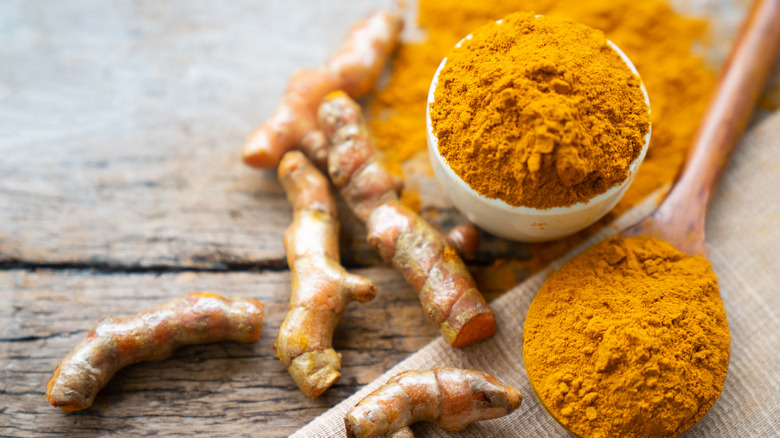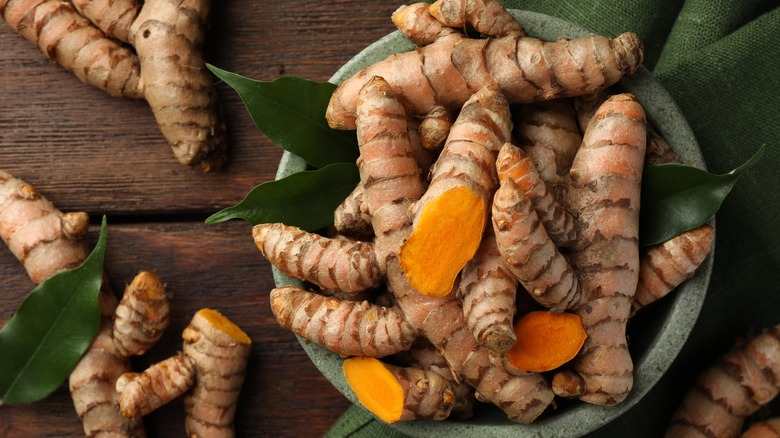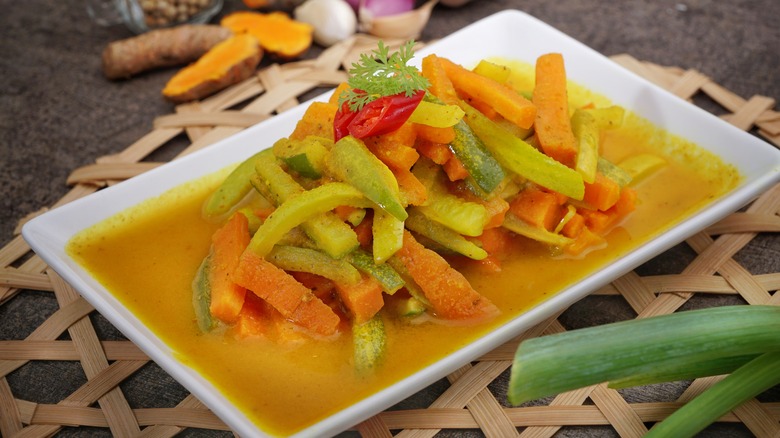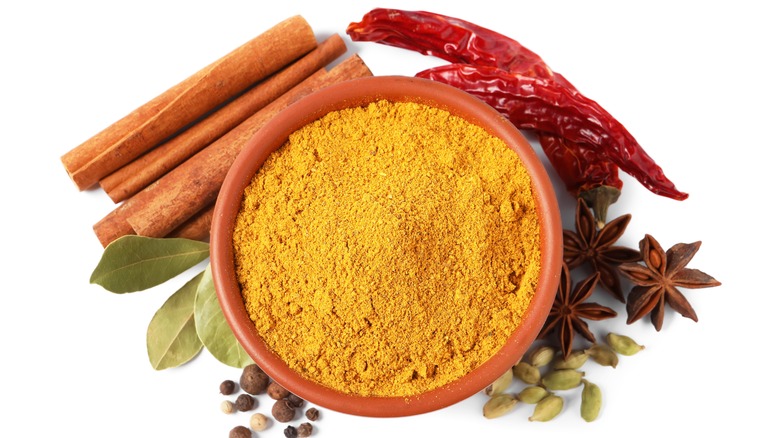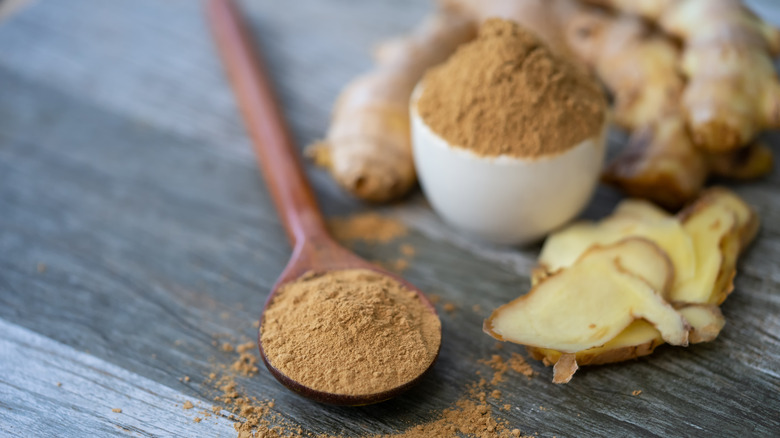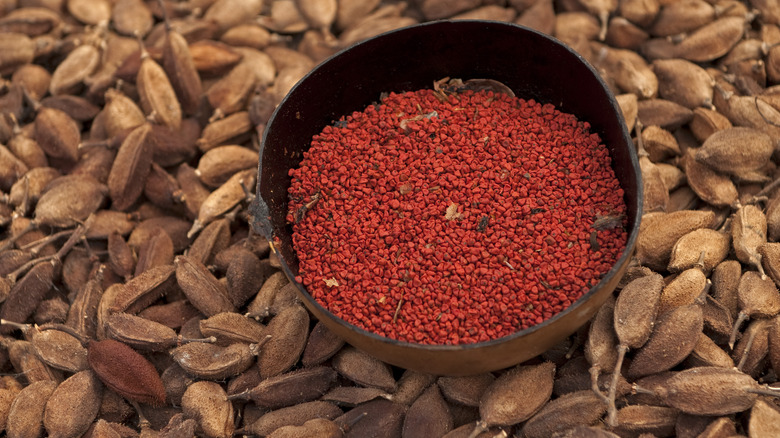The 6 Best Substitutes For Turmeric
Edible roots come in many shapes and forms, but few offer a vibrant dose of both color and flavor quite like turmeric. Hailing from South Asia, the rhizome takes on a wide-range of uses, traditionally used as a dye and medicine in addition to a plethora of culinary applications. So, if you even only dabble in Asian cooking, you'll want a container of this plant in powdered form hand in the pantry. And if you happen to run out, a last-minute substitute is essential, or else the resultant dish won't shine.
Chowhound garnered insight from acclaimed Chef Varun Inamdar, who can be seen on YouTube's Rajshri Food, to help find a suitable replacement. Owner of 27 Degrees West in Singapore, Anokhi Bar & Grill in Shanghai and New Light Sopore in Kashmir, he's certainly well-versed in the spice. Foremost, he cautions that it's "difficult to replace the earthiness, depth and complexity." So, unfortunately, your best bet will be to head to the store. However, if the turmeric isn't front and center, Chef Inamdar acknowledges, "color and flavor hints can be managed." Luckily, there are alternatives worth trying — a few of which you might already have on hand.
Reach for fresh turmeric for a richer flavor and color
When using turmeric in the kitchen, most think of the powdered form — it's more stable and ubiquitous. However, don't forget the power of the raw root, which might just improve your dish. "Grate fresh turmeric root for a more potent flavor," Varun Inamdar recommends; a relatively straightforward substitution. Just remember you'll need "less than the recipe calls for in powdered form," he says.
The raw version is loaded with more curcumin, which gives the root its bright yellow color and potential anti-inflammatory benefits, per WebMD. So, especially if you're after the purported health effects of a turmeric latte, or the color in a curry, fresh turmeric is not just a good alternative, it's an enhancement.
Employ pickled turmeric for a fermented twist
Next up, Varun Inamdar suggests that seeking out pickled turmeric is a helpful substitution. Known as kachi haldi ka achar, this regional Indian speciality combines the peeled root with citrus juice salt, and optional chiles and spices for a funky, preserved mix. Its flavor comes even punchier than raw, adding in spice, salt, and tartness.
As a result, Inamdar recommends to "finely chop and add it to dishes for both color and a tangy, fermented twist." This ingredient isn't made for simmering and melding with other spices, but rather acting as a finishing raw flourish alongside a meal, like fresh roti made with stone-ground flour.
Saffron can replicate turmeric's vibrant color
When it comes to the intensity of color and aroma, saffron is turmeric's equal. The flavor's more delicate, with less earthy notes and increased florality, but nonetheless incredibly complex. Plus, it comes with another advantage — Varun Inamdar urges to "use sparingly to mimic the yellow color."
In slow-simmered, liquidy dishes, it's one of the few workarounds for equally eye-catching golden hues. And it'll tone down the intensity of the palate, with "a distinct, delicate warm and sweet flavor," says Inamdar. If you're wondering how to use saffron, just remember you'll need to soak it in liquid first, otherwise it won't release all of its contained aroma.
Curry powder often contains turmeric
It's entirely possible that you have turmeric in your pantry and don't even know it — just check your curry powder. These pre-mixed spice blends "can be a flavor and color substitute in the closest way," Varun Inamdar notes. Melding together varying vibrant aromatics, they contain ingredients such as pepper, cumin, and ginger, so you certainly won't be compromising intensity of flavor with this substitution.
However, you may want to check that your curry powder is tailored to the type of food you're cooking. In addition to spice mixes with Indian accents, curry seasonings are popularly used in Caribbean, East, and Southeast Asian cuisines, among others.
Ground ginger is a similar replacement
You can also turn to another familiar rhizome, and substitute ginger in for turmeric. The two products share commonalities in their shapes, textures, and applications, and are both available ground. Varun Inamdar says the root "provides a warm, earthy flavor similar to turmeric, though without the color."
Take note that ground ginger brings more spice and pungency, which will amplify aromatic dishes, but can be overwhelming in certain applications. Nevertheless, the two ingredients are often used in combination, so it's certainly a swap worth considering.
Annatto seeds also lend a vibrant color
If you're after turmeric's bright colors, then turn to the often-overlooked annatto seed. Popular in cuisines across the Americas and the Philippines, the spice is what lends foods like cochinita pibil and sazón their dramatic orange hue. "The flavor is more peppery and sweet," Varun Inamdar advises, so it's not a perfect replacement taste-wise.
Nevertheless, annatto's hue is similar to a mix of turmeric and paprika, making it a suitable substitution visually. Plus, when purchased in ground form, the spice is just as easy to incorporate into any dish.
